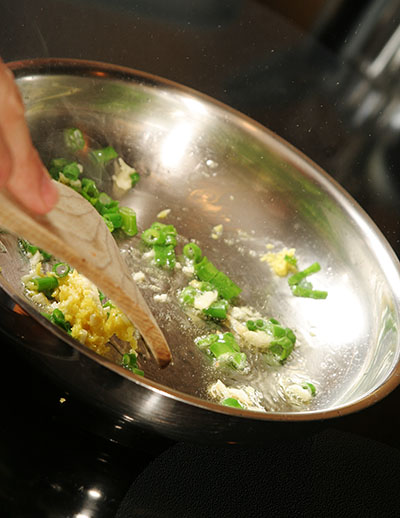Cornish Game Hen with POM Pomegranate Glaze
March is the turning point between spring and winter, and for this month's POM blog entry, I wanted to say goodbye to winter by roasting rock cornish game hens, with an Asian-inspired pomegranate juice glaze.
A game hen actually isn't a game hen, it's merely a young chicken -- sort of the equivalent of lamb and veal for chickens. I find the taste to be more distinctive than a full-grown chicken, but it's not a gamey taste, just a little more flavorful.
The French have, at the base of many sauces, their mirepoix of carrots, celery, and onion. New Orleans has its version with celery, onion, and green pepper. Many Asian regions sauté ginger, garlic, and scallions to infuse their sauces with flavor, and that's the concept I used with this dish.
There are few ingredients: A bit of "Asian mirepoix", some honey for caramelization and thickness, and pomegranate juice for its complex, complementary flavor.
Ingredients: 2 rock cornish game hens (approximately 20 oz each) 1/2 cup POM 100% pomegranate juice 1 1/2 tablespoons honey 1 large clove garlic, minced 2 tsp minced fresh ginger 2 scallions, chopped 2 teaspoons vegetable oil
Heat small saucepan over medium high, then add vegetable oil. When oil is hot, add garlic and ginger and sauté briefly until fragrant, stirring with a wooden spoon. Add scallions and stir until softened. Add 1/2 cup POM 100% pomegranate juice and reduce heat to low. Add honey and stir until incorporated into glaze. Keep glaze warm.
Preheat oven to 350. Tie hens and dry-roast for 15 minutes. Baste skin of hens with glaze and bake for 15 more minutes. Repeat every 15 minutes until 1 hour total cooking time. Internal temperature near the thigh should be 160 degrees. Serve with rice and chopped scallions for garnish.

Cut the skin off the ginger and grate finely. Chop the scallions and mince the garlic clove.




(Our daughter Meta was only interested in the POM juice)

Sauté garlic and ginger in a hot, oiled pan, then add scallions:



Add the POM juice and the honey and keep on low heat.



Rinse and pat the hens dry, and snip off the outer joint of the wings. To tie the hens, imagine you're trying to create a shape similar to an American football. The bird is one dense piece, with no bits sticking out that may get overcooked. I've tied a lot of birds, and the tying job looked different for almost every single one, so don't be shy about what your nest of string looks like. It can look like a boy scout first-aid manual, as long as the legs are snug over the breast, and the wings are tucked in close.



 (I just noticed the tail fell out of my tying job -- embarrassing, but at least the rest of the bird is tight!)
(I just noticed the tail fell out of my tying job -- embarrassing, but at least the rest of the bird is tight!)
Roast for 15 minutes at 350, then every 15 minutes after that, baste the POM glaze over every bit of the birds' skin. At the one hour point, the birds should be done, and the glaze should have browned nicely in parts.



Plating was a single hen (minus string) served with rice with chopped scallions as garnish.

Deconstruction: I normally prefer roast chickens to be dry-roasted, but the smaller hens work really well with a glaze or flavorful baste and I almost always baste them with some flavor with impact. The POM juice complements the Asian base to deliver a lot of flavor -- the garlic and ginger were present, as well as the greenness from the scallions, but the depth of fruit flavor from the pomegranate was definitely up front -- a cranberry/raspberry sort of flavor similar to glazed duck. Given the small size of cornish hens, there's a flavor burst from the skin and a mellowness from the meat in almost every bite.



